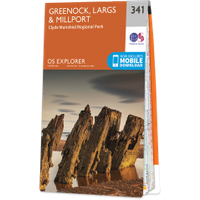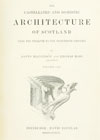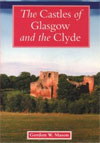

Castle Levan is an interesting twin towered castle dating back to the 14th and 16th centuries, and is now restored and run as a bed and breakfast.
The castle, which may have been built on the site of an earlier building, is thought to have been built by the Morton family. It occupies a good defensive position on the edge of the steep and deep ravine of the Leven Burn with extensive views across the Firth of Clyde.

On the north side of the site is a rectangular tower thought to date to the late 14th century. Measuring approximately 10.6m north-north-west to south-south-east by approximately 7.9m across it has walls some 1.5m thick and rises to a height of three storeys plus a garret within a corbelled parapet walk with roundels.
The original entrance was at first floor level in the south wall and would have been reached by an external stair, however it was later converted into a window. High above the entrance, at second floor level, was a carved niche for an armorial panel.
Immediately below the original entrance is a later opening at ground floor level which leads into a narrow corridor within the thickness of the wall. On the ground floor are two vaulted basement chambers. A straight, narrow intramural staircase leads up from the west end of the corridor to the first floor. A service stair in the north wall leads up from the eastern cellar.
The first floor contains the great hall with stone seats within recessed windows. A spiral staircase leads up from the south-west corner of the great hall to the westernmost of two bedrooms above on a wooden floor supported by corbels.
Originally a barmkin extended from the south side of the tower, with an inside width of 13.7m, enclosing a courtyard area. In the 19th century a vaulted chamber was still visible to the south of the castle and probably represents the basement of a building attached to the barmkin.

Edinburgh, 1887
Early in the 16th century a second three storey tower was built on the site of the barmkin’s east wall, the north-west corner of the new wing being joined to the south-east corner of the original tower. Within the adjoining corners is a turnpike stair leading up from the ground floor to the first floor. The new wing is also rectangular in plan and measures approximately 8.0m west-north-west by 6.3m east-south-east. Like its neighbour it features 1.5m thick walls, but has only one vaulted basement cellar above which is a kitchen with large fireplace on the first floor and a bedroom on the second floor.
It has been speculated that the building of the wing was commenced before the main tower was completed as the chequered corbelling and parapet walks with roundels match perfectly. However it is more likely that when the new wing was added the top of the earlier tower was remodelled to incorporate it into that of the new one.

Adam Morton of Levane, a cadet of the Mortons of Walkinshaw, sold the castle to William Sempill, 2nd Lord Sempill, before 1539. Other sources state that Morton may have alienated the lands to Lord Sempill in 1547, the year he died, and that Sempill absorbed them into his own barony of Semple that year. Adam’s son, James Morton, took legal action but eventually lost.
Legend has it that Castle Levan is haunted by a ghost known as the White Lady and said to be William Semple’s third wife Mariota or Marion Montgomery, daughter of John Montgomerie of Hessilhead. The story goes that she tortured and killed “tenants” of the castle. Mary of Guise sentenced her to death, a punishment later commuted to imprisonment in the castle. When Lady Montgomery’s husband returned from military duty he was supposedly so disgusted by her behaviour that he locked her up and she starved to death. The fact that Lady Montgomery outlived her husband, who died in 1552, and went on to marry John Campbell of Skipness is neither here nor there.
Castle Levan is said to have been acquired by the Stewarts of Ardgowan in 1649, although I haven’t been able to find the exact circumstances surrounding this transfer.
Ann or Anne Sempill, the eldest daughter of Robert Sempill, 4th Lord Sempill, married Sir Archibald Stewart of Castlemilk in 1603. One of Sir Archibald’s sisters, Margaret, married John Stewart of Blackhall and Ardgowan, and it seems that this is how the Sempills and Stewarts of Ardgowan became linked. In 1672 there was a ratification in favour of Anne and Sir Archibald’s grandson, Sir Archibald Stewart of Blackhall, which included Levan.
In the 18th century the Stewarts became the Shaw-Stewarts and in the 19th century they built a new house, also called Castle Levan, just to the north of the old towers. The old castle fell into disrepair, the east wall of the south-east wing collapsed and its entrance was partially buried by earth and rubble.
The New Statistical Account, published between 1834 and 1845, refers to Leven being the seat of a Mr Crooks. In “Days at the Coast”, published in 1878, Macdonald mentions that the castle was covered in ivy and access was allowed by the owner Mrs Crooks. In 1879 Castle Levan was seemingly owned by John Polson, the cofounder of Brown & Polson corn merchants.
The early 20th century history of Castle Levan is poorly documented however it seems to have been kept as a picturesque folly within the grounds of the new mansion.
Excavations in 1966 and 1970 to 1972 revealed evidence of the original barmkin and a kitchen midden was discovered on the east side of the castle’s south tower. It was found to contain around 5000 pieces of bone and seashells inlcuding oysters, along with mid-15th to early 16th century green-glazed pottery and a mid-17th century spurred clay pipe bowl. The foundations of what was interpreted as a possible gatehouse were found in the courtyard area.
A programme of reconstruction began in 1980, with a full refurbishment being carried out between 1984 and 1987 by the architect Ian Begg who had been commissioned by the then owners advertising executive and art collector David Pearson and his wife Sheila. The Pearsons made the castle their family home until their retirement in 1995 when they sold it, after which it was converted into a bed and breakfast.
Alternative names for Castle Levan
Laven Castle; Levan Castle; Levane; Leven Castle
















